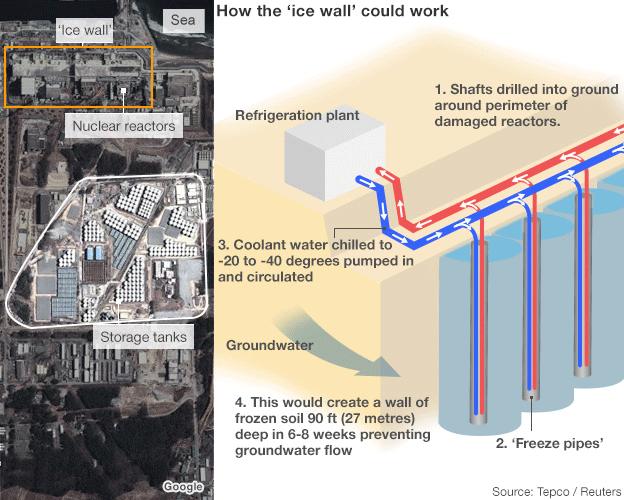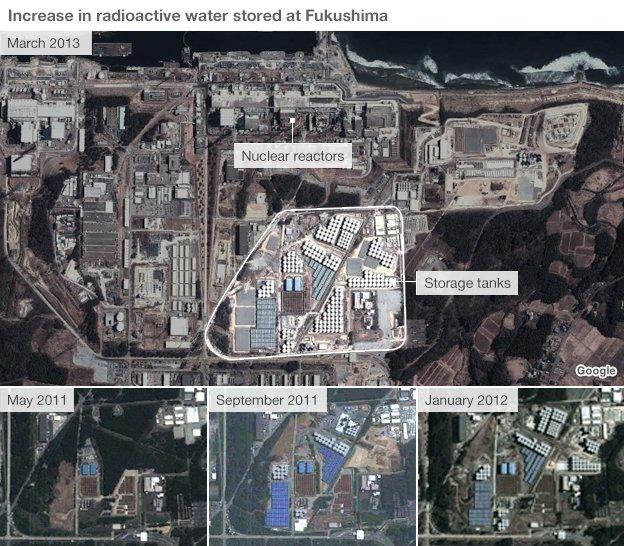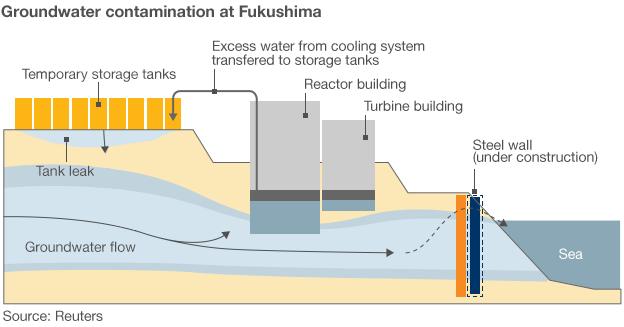Fukushima leaks: Japan pledges $470m for 'ice wall'
- Published
Joanna Gosling explains where the leaks are coming from
Japan is to invest hundreds of millions of dollars into building a frozen wall around the Fukushima nuclear plant to stop leaks of radioactive water.
Government spokesman Yoshihide Suga said an estimated 47bn yen ($473m, £304m) would be allocated.
The leaks were getting worse and the government "felt it was essential to become involved to the greatest extent possible", Mr Suga said.
The plant was crippled by the 2011 earthquake and tsunami.
The disaster knocked out cooling systems to the reactors, three of which melted down.
Water is now being pumped in to cool the reactors, but storing the resultant large quantities of radioactive water has proved a challenge for plant operator Tokyo Electric Power Company (Tepco).
'Closely watching'
Under the government plan, a wall of frozen earth will be created around the reactors using pipes filled with coolant to prevent groundwater coming into contact with contaminated water being used to cool fuel rods.

Water treatment systems will also be upgraded to tackle the build-up of contaminated water, officials said.
Dr Tatsujiro Suzuki, vice chairman of the Japan Atomic Energy Commission, told the BBC that the situation at the nuclear power plant was an "unprecedented crisis" and that it was "getting worse".
He said the plan to freeze the ground around the site was "challenging", and a permanent solution was needed.
The technique has only been used on a small scale to control pollution before but not with radioactive contamination, he added.
The damage to the plant has necessitated the constant pumping of water to cool the reactors - a process which creates an extra 400 tonnes of contaminated water every day.
That water is being stored in temporary tanks at the site. Last month Tepco said that 300 tonnes of highly radioactive water had leaked from one of the tanks, in the most serious incident to date.

Satellite images show how the number of water storage tanks has increased in the past two years. The tanks store contaminated water that has been used to cool the reactors.
But in recent months there have also been leaks from pipes and there are concerns that water is seeping from damaged reactor buildings into the ground.
Last month, Japan's nuclear regulator classified the severity level of radioactive water leak issues at Fukushima as a three on the seven-point International Nuclear and Radiological Event Scale (Ines).
The triple meltdown at Fukushima two years ago was classed as a level seven incident, one of only two nuclear events ever rated that highly - along with the 1986 Chernobyl disaster in the former Soviet Union.
"The world is closely watching whether we can dismantle the (Fukushima) plant, including the issue of contaminated water," said Japanese Prime Minister Shinzo Abe.
"The government is determined to work hard to resolve the issue."
The funding pledge comes days before a decision is due on the host nation for the 2020 summer Olympic Games, for which Tokyo is a candidate.
Meanwhile, one of Japan's only two nuclear reactors still online was shut down on Tuesday for mandatory inspections.
The shutdown of Kansai Electric's Oi Unit 3 reactor will leave the plant's Unit 4 reactor the only one still functioning in Japan. Unit 4 must also be taken offline later this month for routine assessment.
Restarting Japan's other nuclear reactors remains a highly controversial issue, but the government is working to get this done to fill an energy gap.

Water from the storage tanks has seeped into the groundwater and then into the sea. Efforts to use a chemical barrier to prevent sea contamination have not worked.
- Published23 August 2013
- Published22 August 2013
- Published4 September 2013
- Published5 August 2013